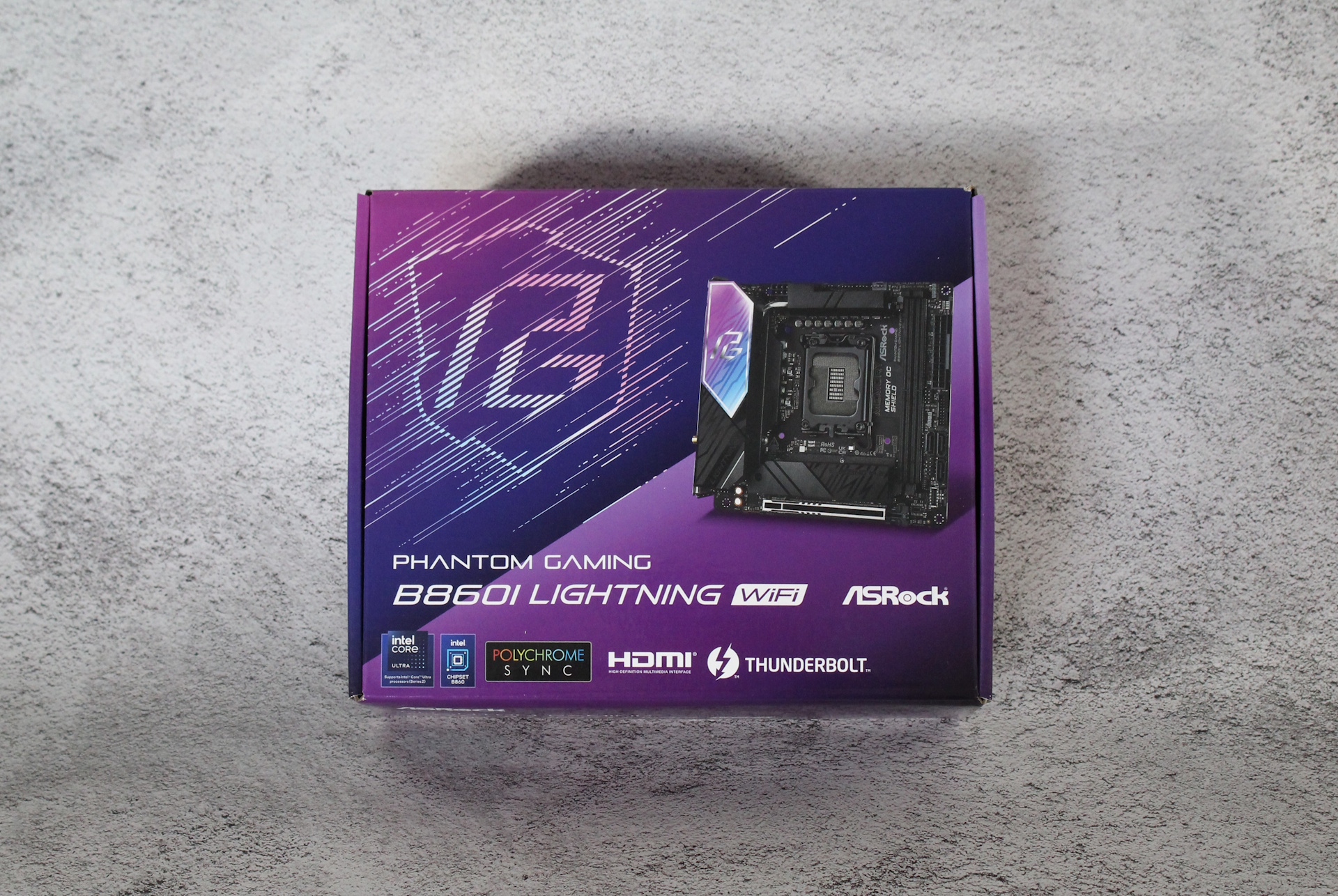Why you can trust Tom's Hardware
Our standard benchmarks and power tests are performed using the CPU’s stock frequencies (including any default boost/turbo) with all power-saving features enabled. We set optimized defaults in the BIOS and the memory by enabling the XMP profile. For this baseline testing, the Windows power scheme is set to Balanced (default) so the PC idles appropriately.
Synthetic Benchmarks
Synthetics provide a great way to determine how a board runs, as identical settings should produce similar performance results. Turbo boost wattage and advanced memory timings are places where motherboard makers can still optimize for stability or performance, though, and those settings can impact some testing.
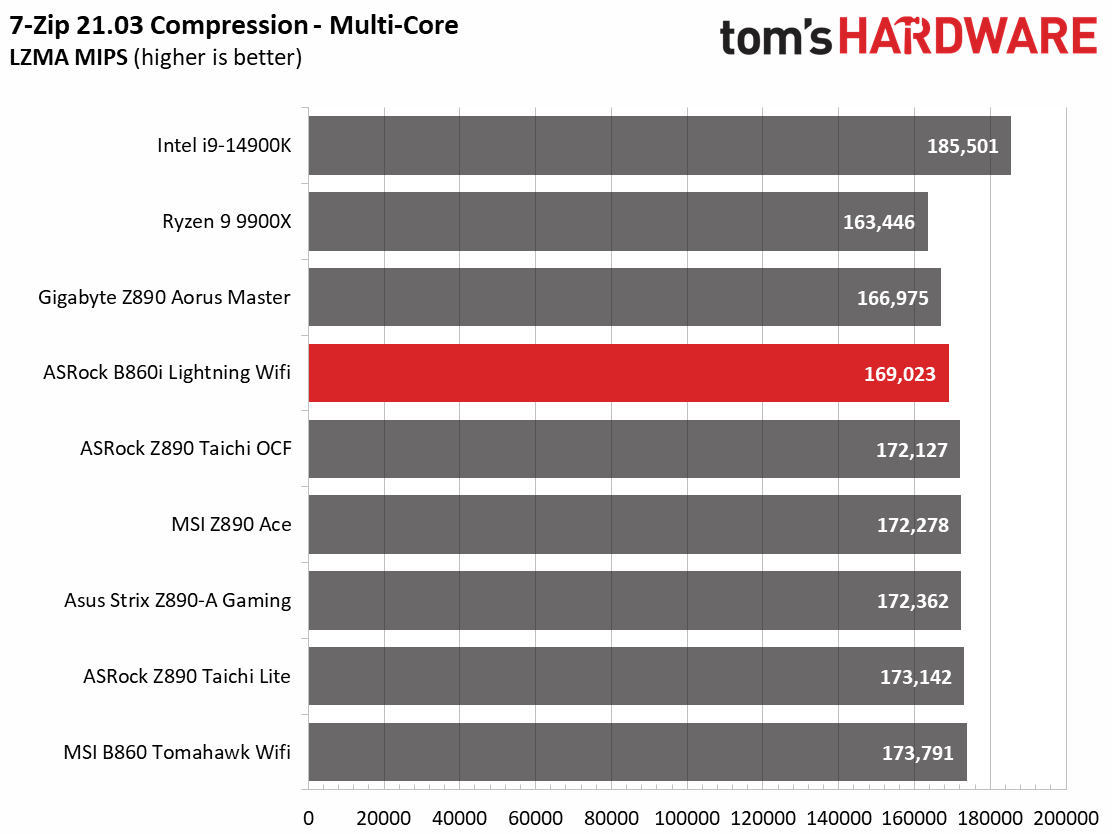
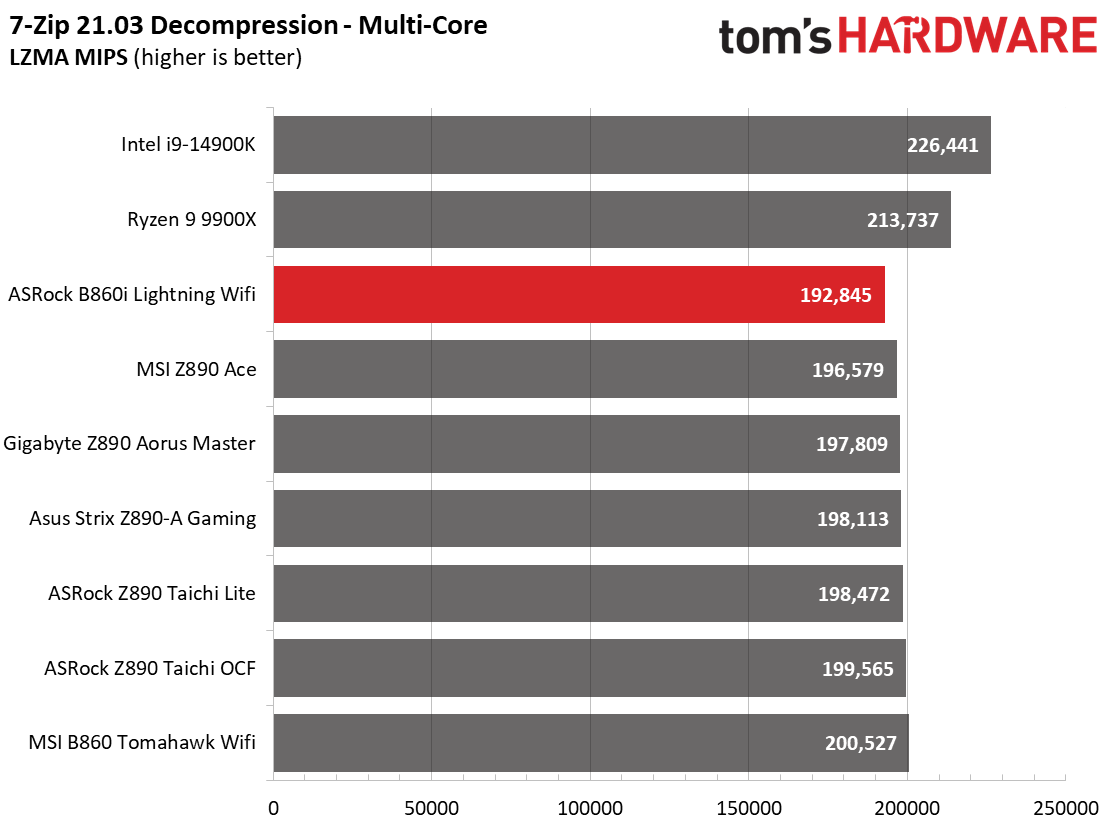
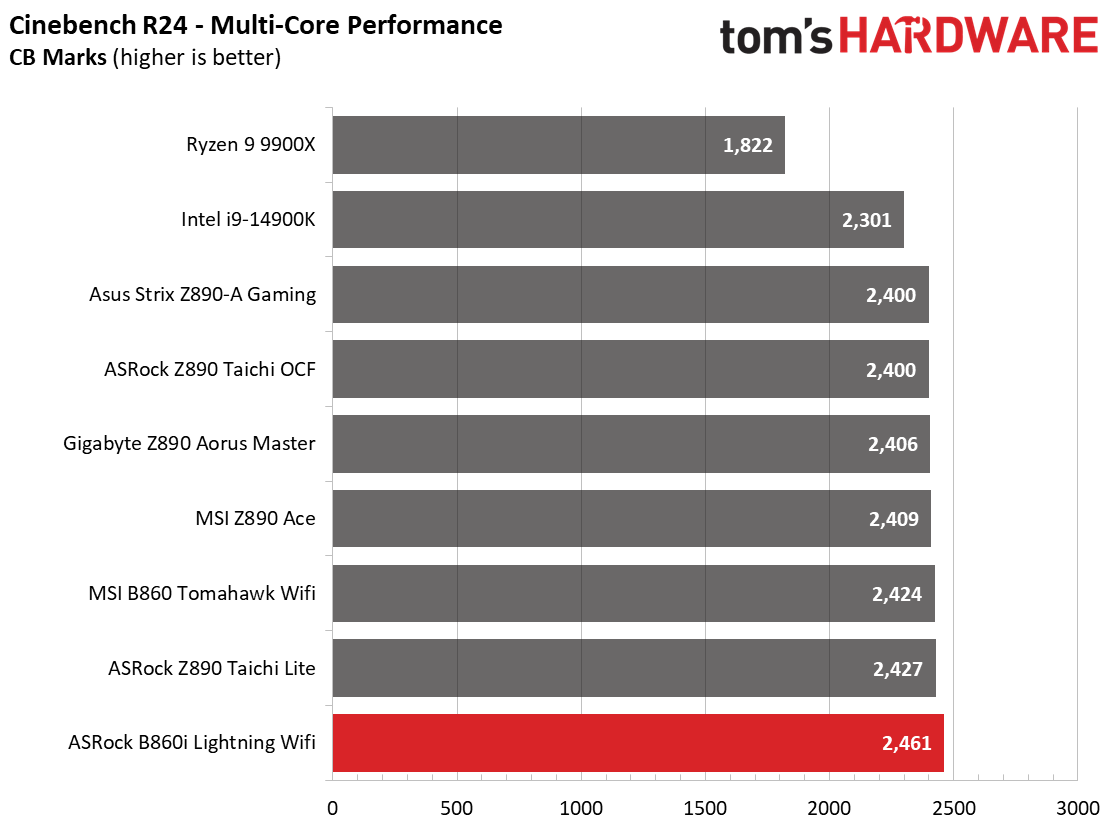

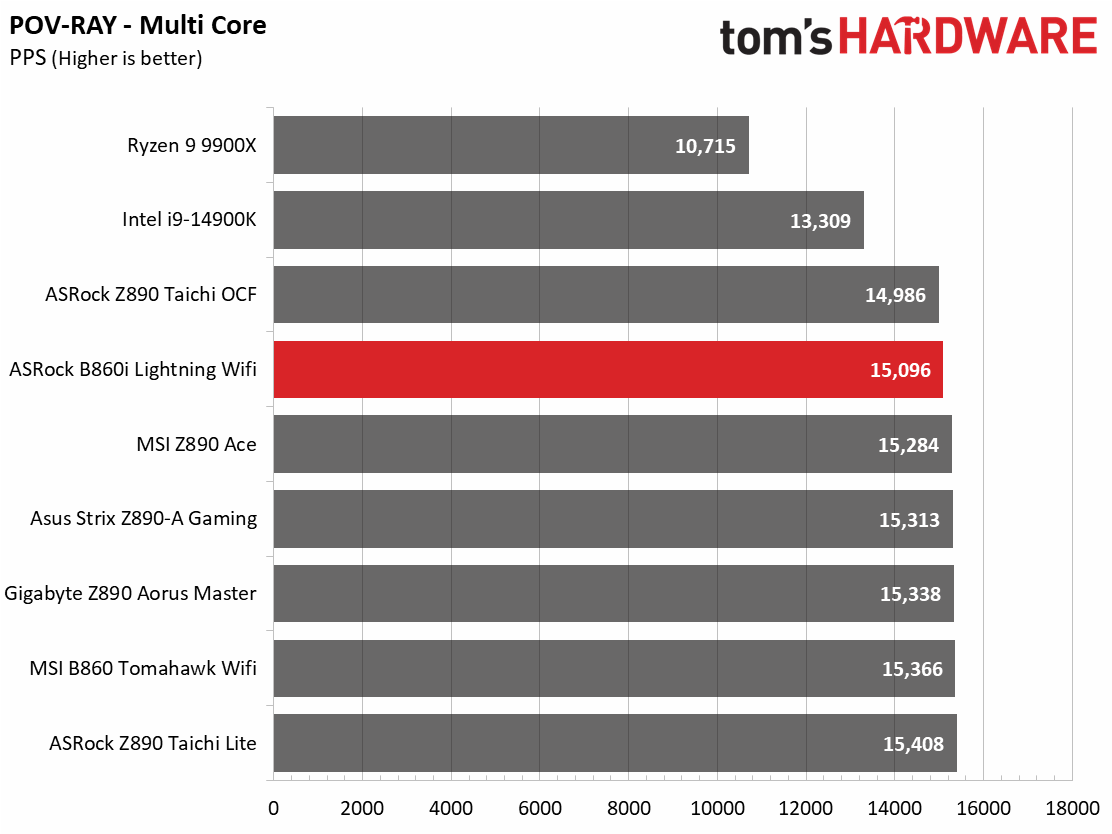
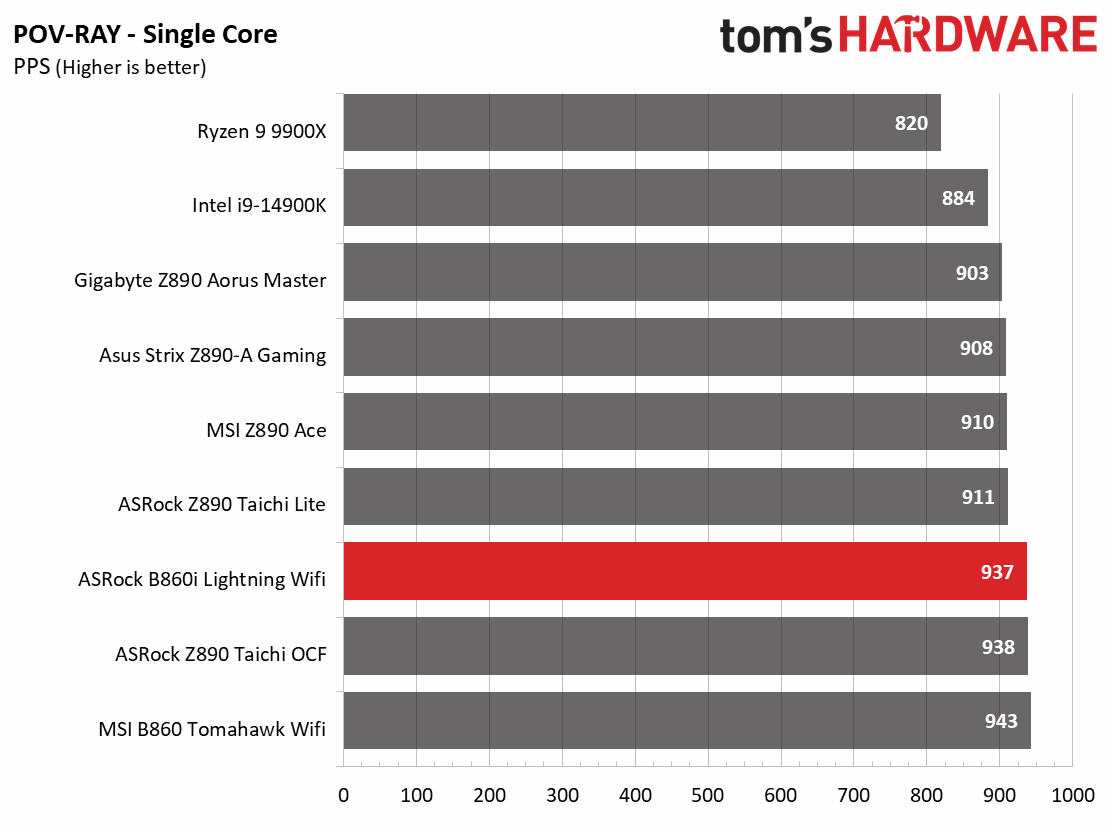
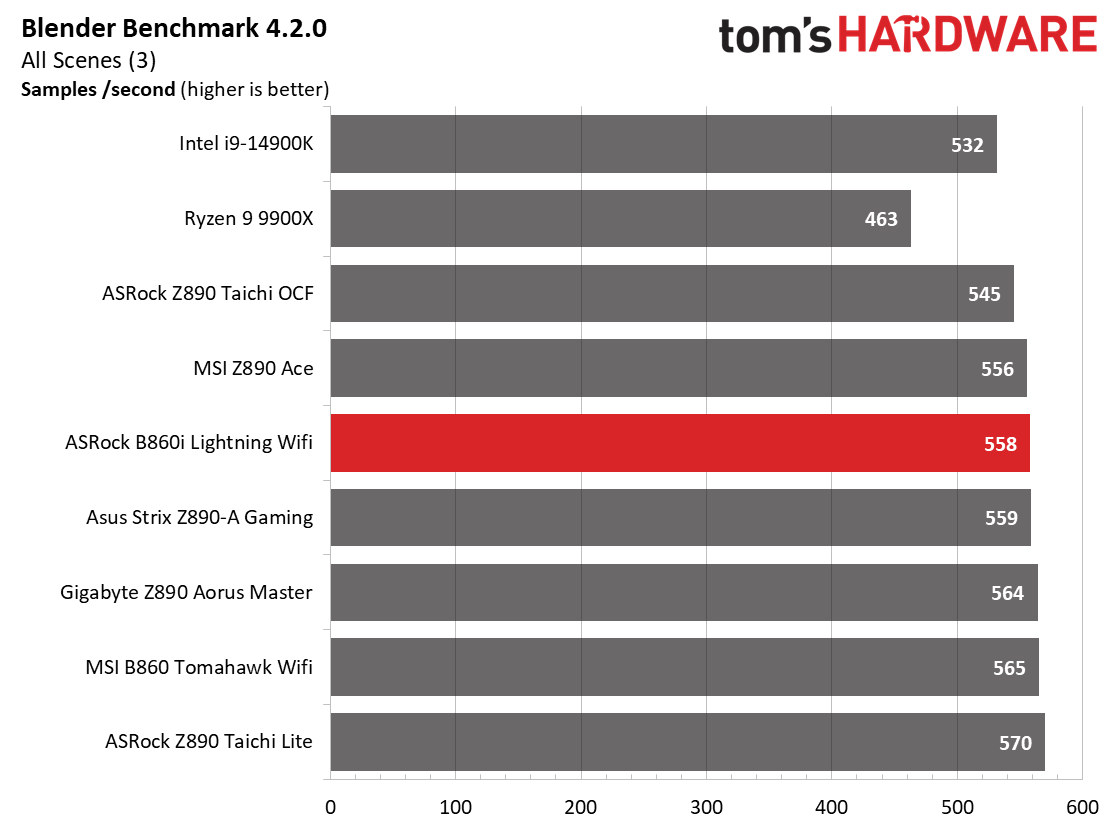
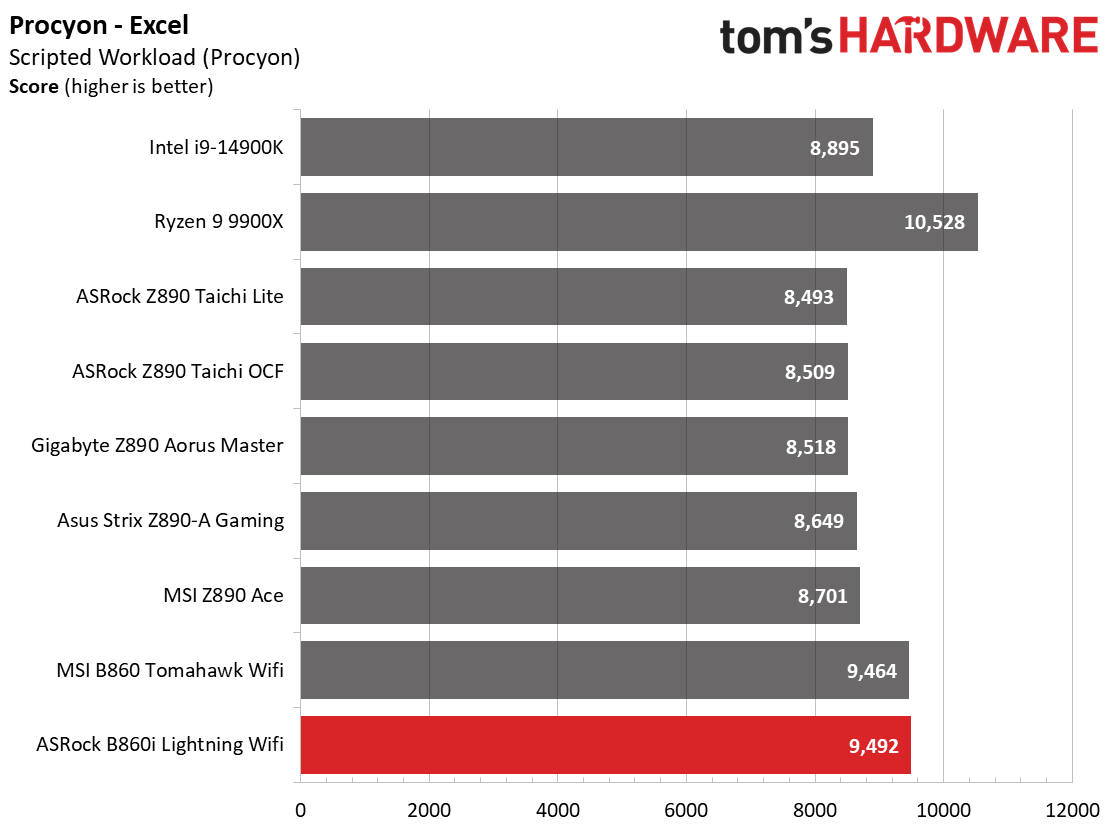
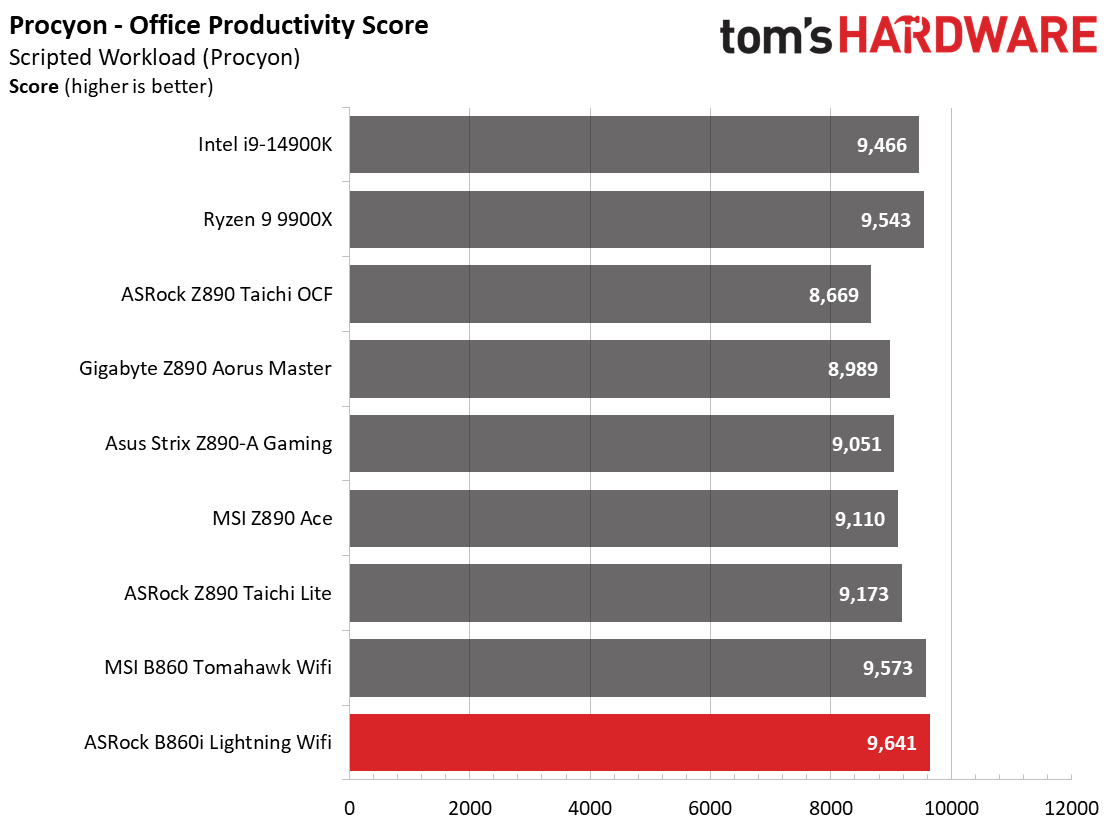
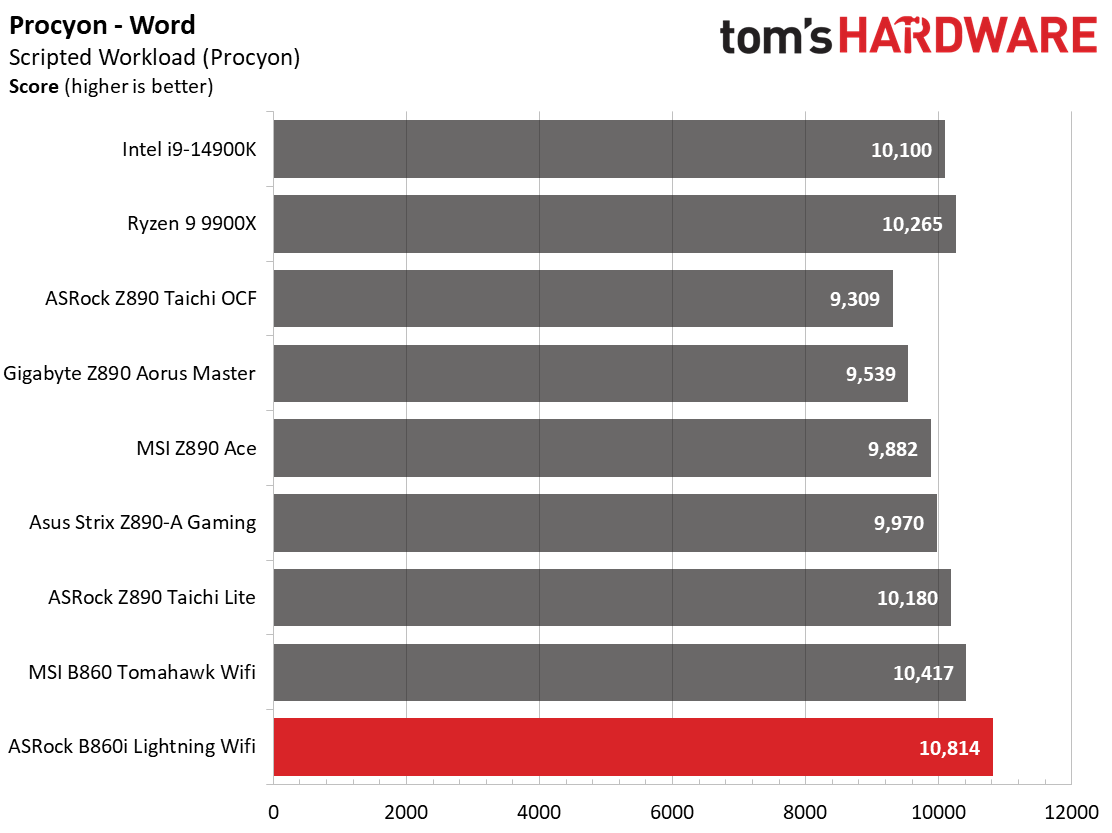
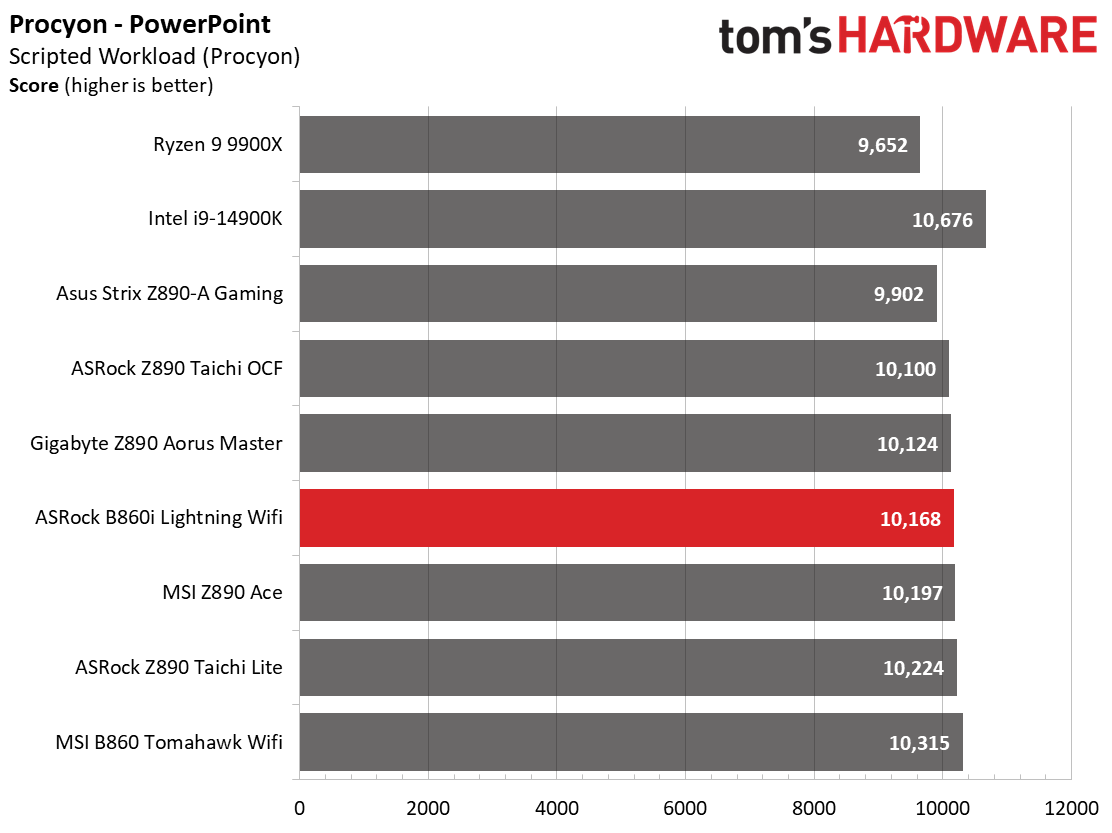
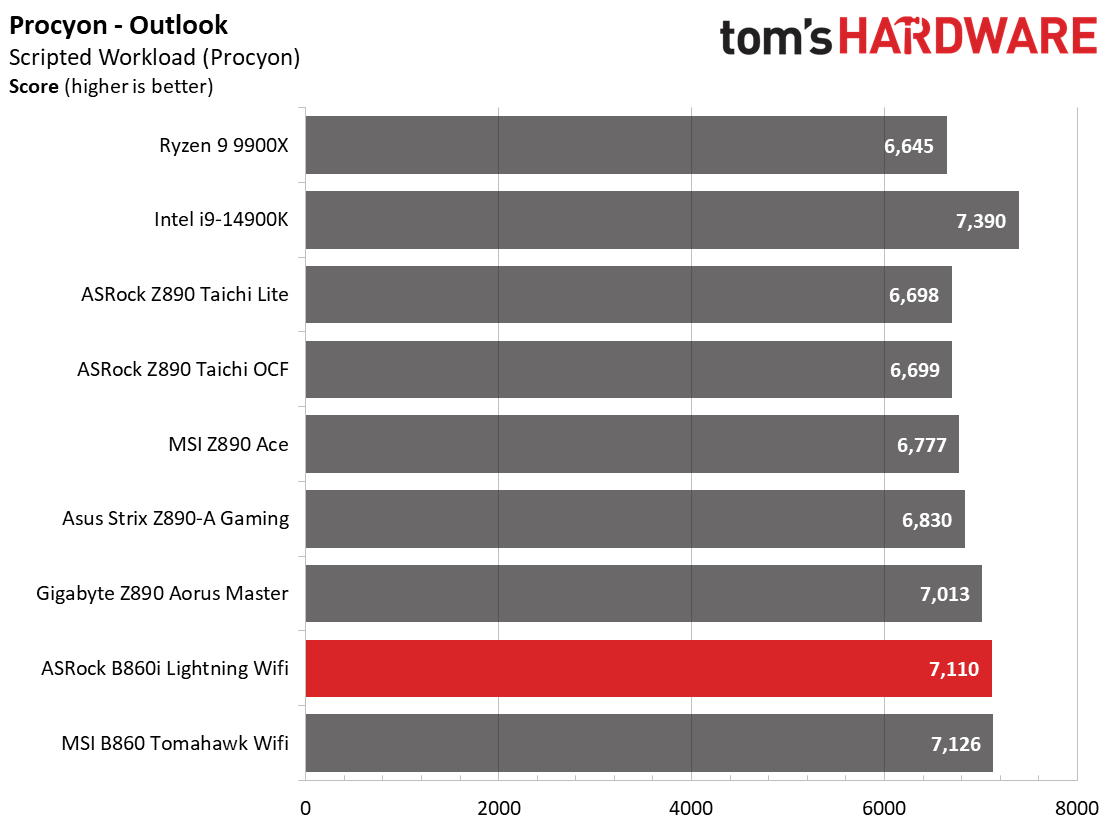
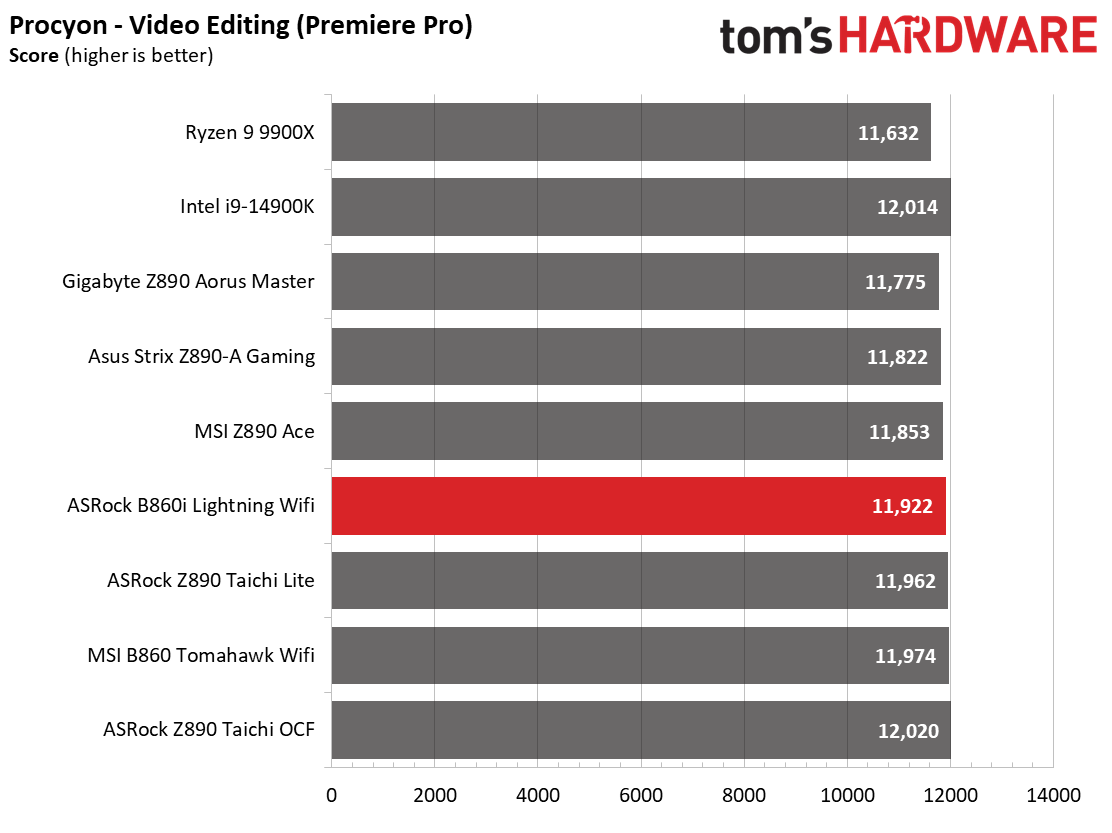
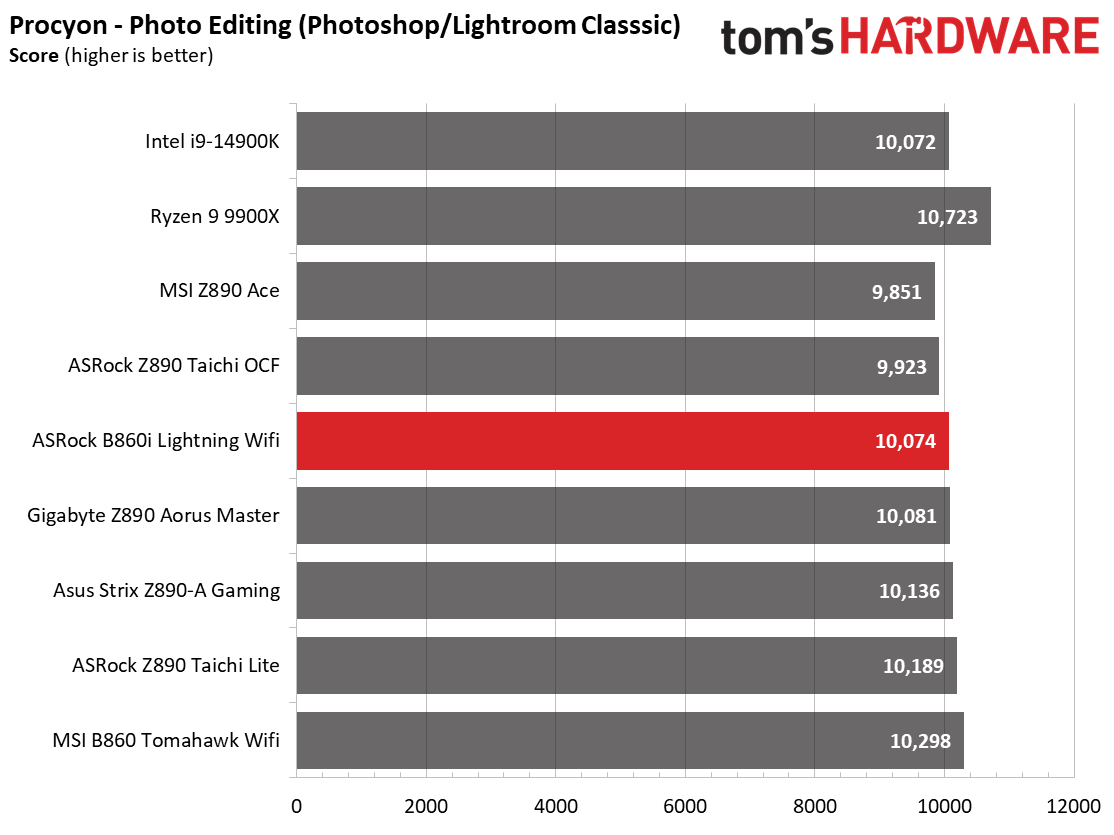
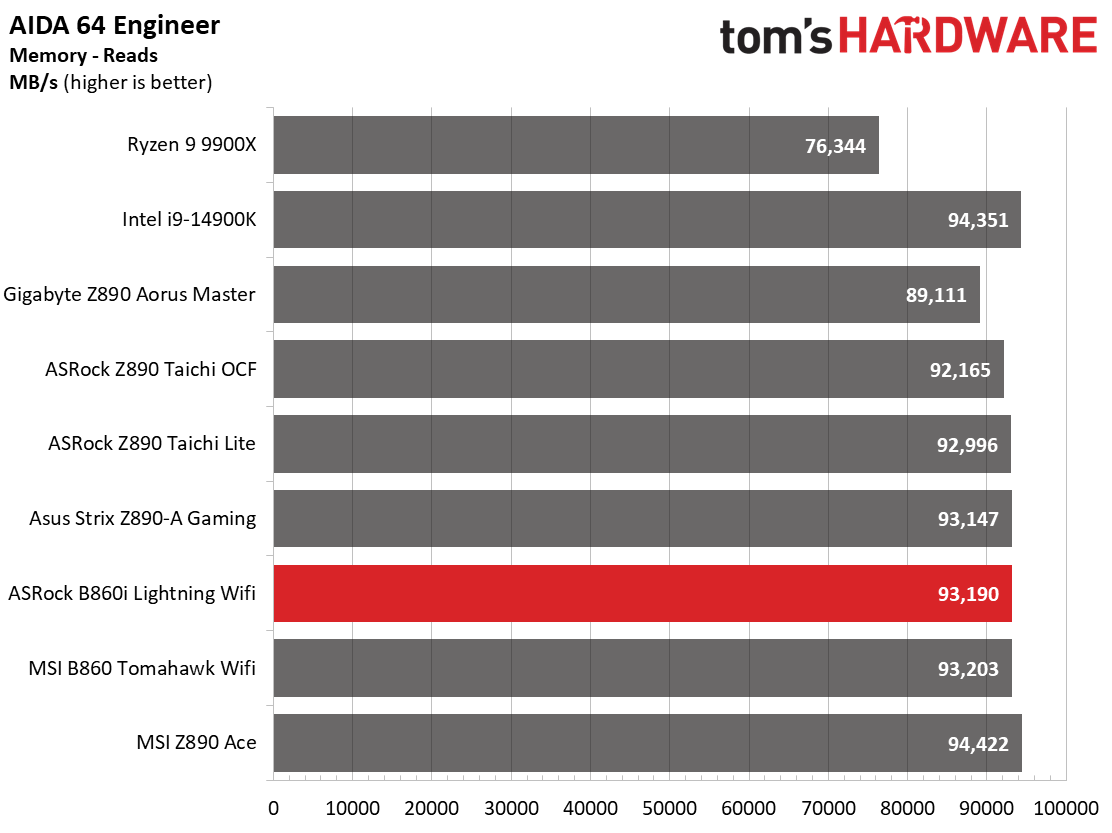

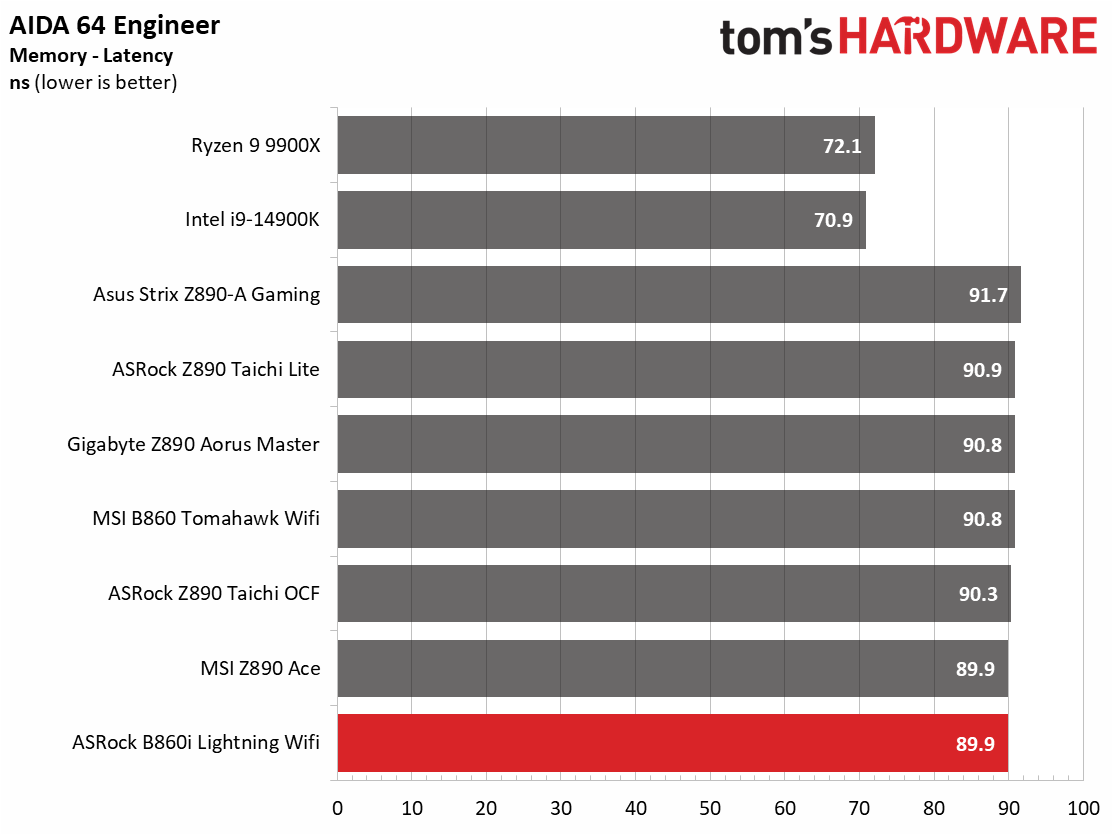
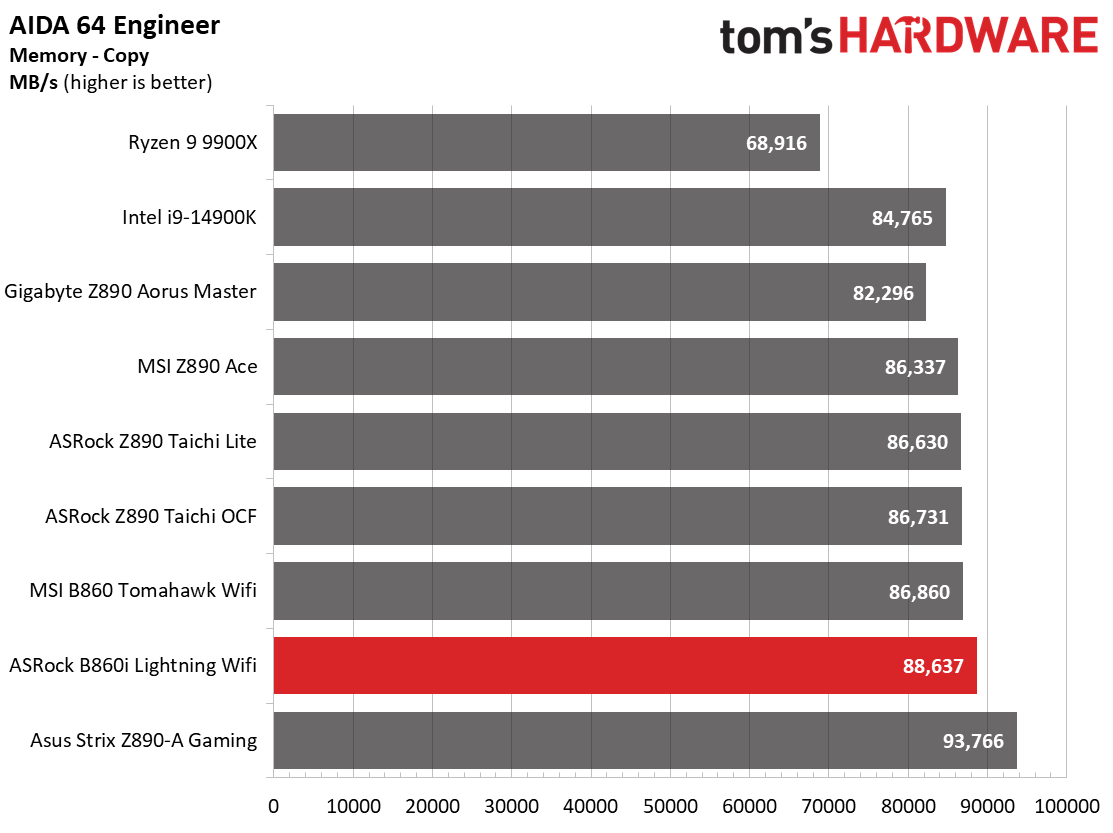
The ASRock board’s performance across synthetic benchmarks was average overall but typically showed polarizing results outside of the Procyon test suite, which remained consistently above average. Although the performance differences in most of these benchmarks aren’t significant, it was still intriguing to observe the fluctuations.
Timed Applications
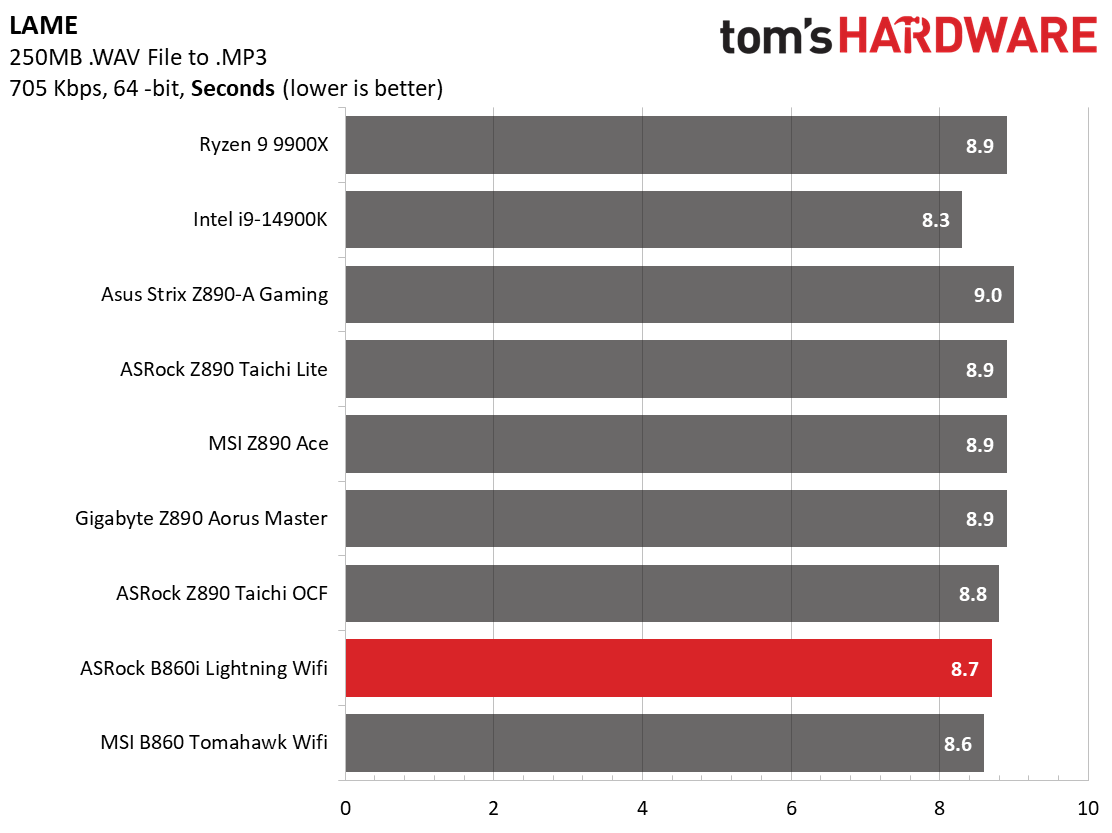
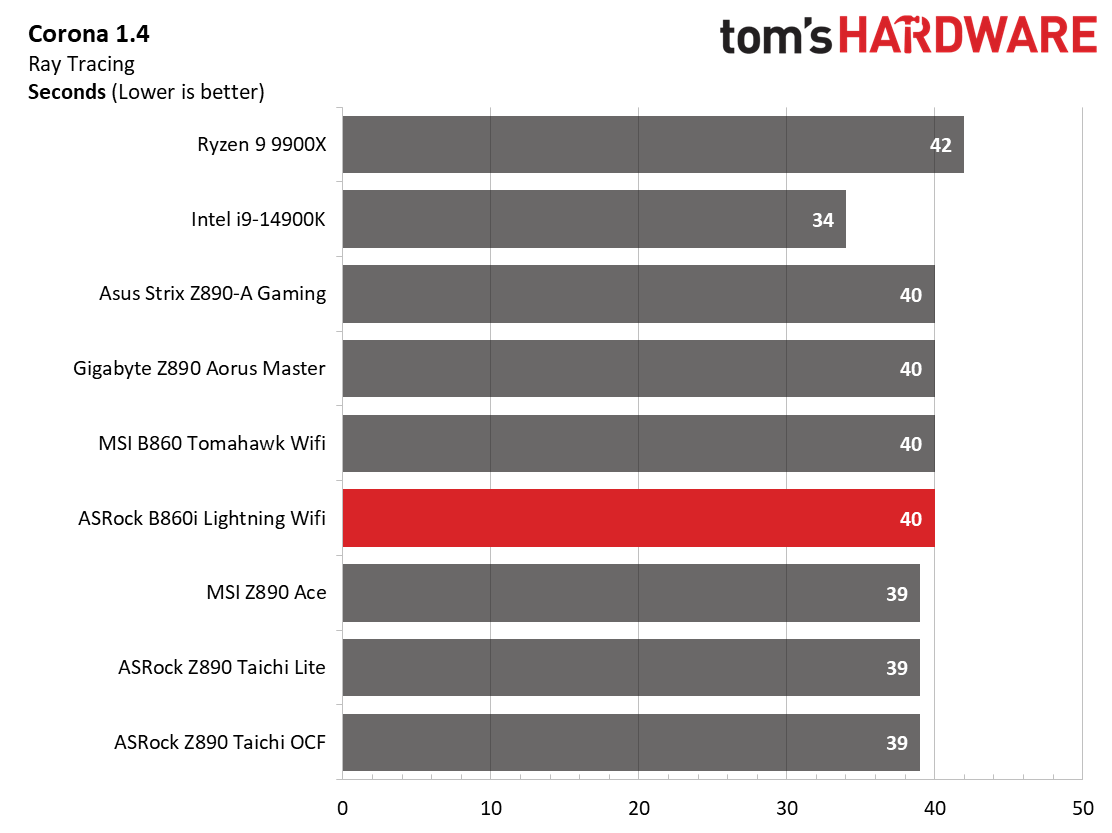
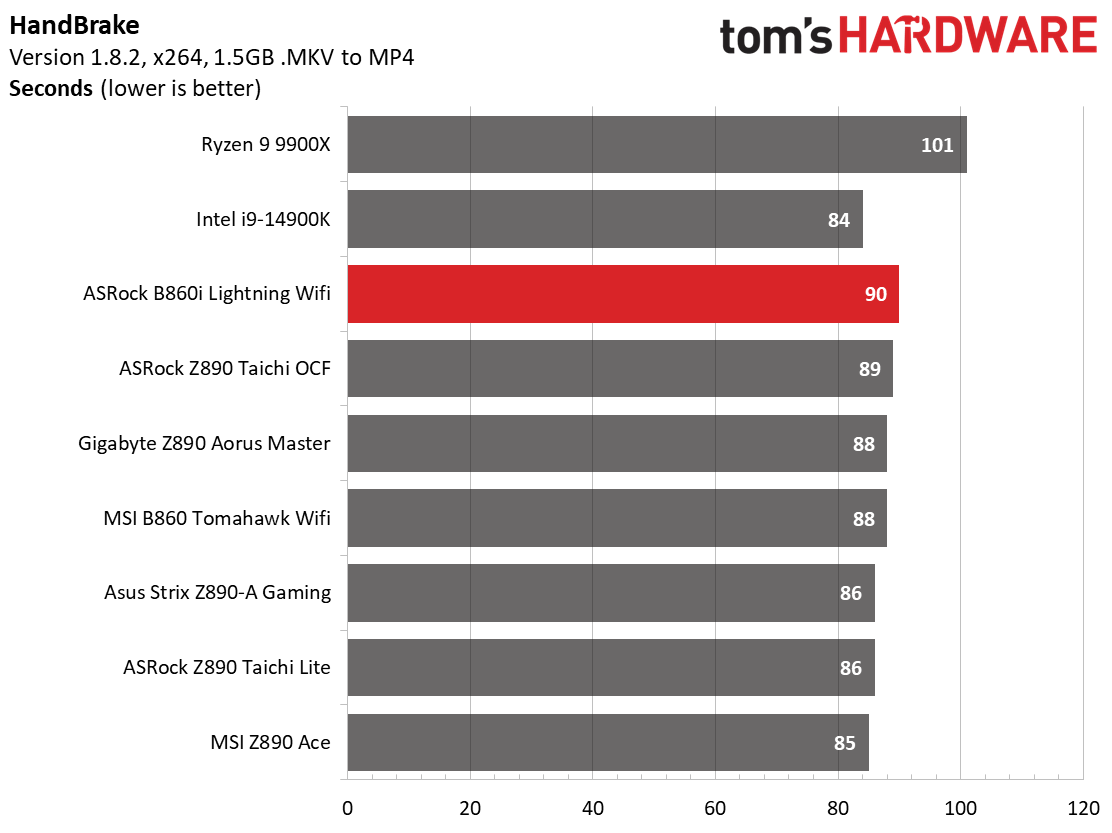
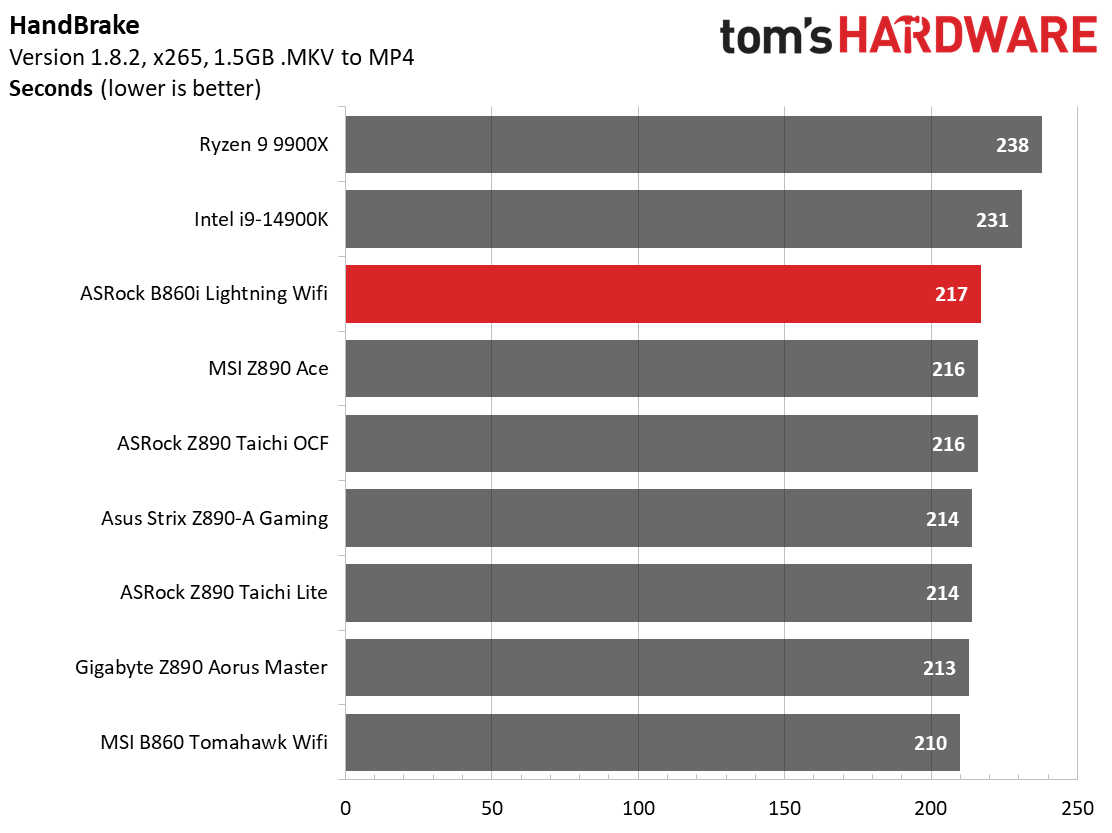
In our timed benchmarks, the B860I Lightning was average in LAME and Corona but recorded the slowest results in both Handbrake tests.
3D Games and 3DMark

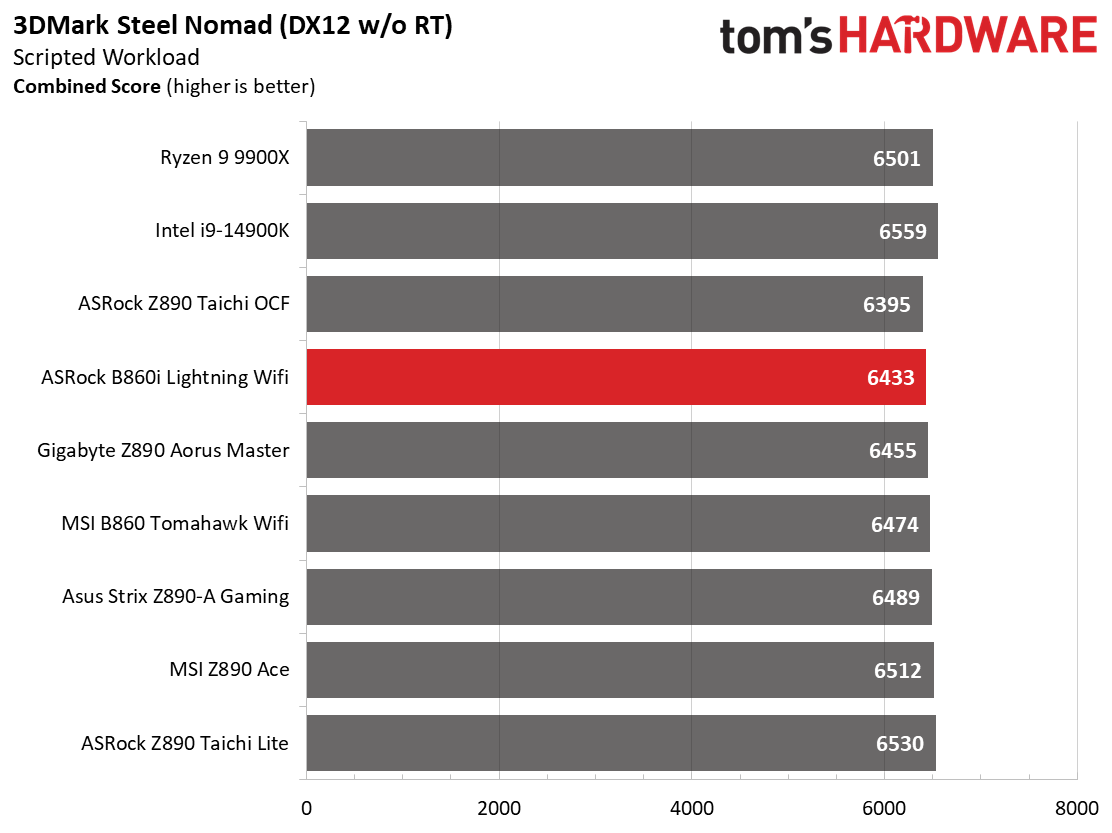
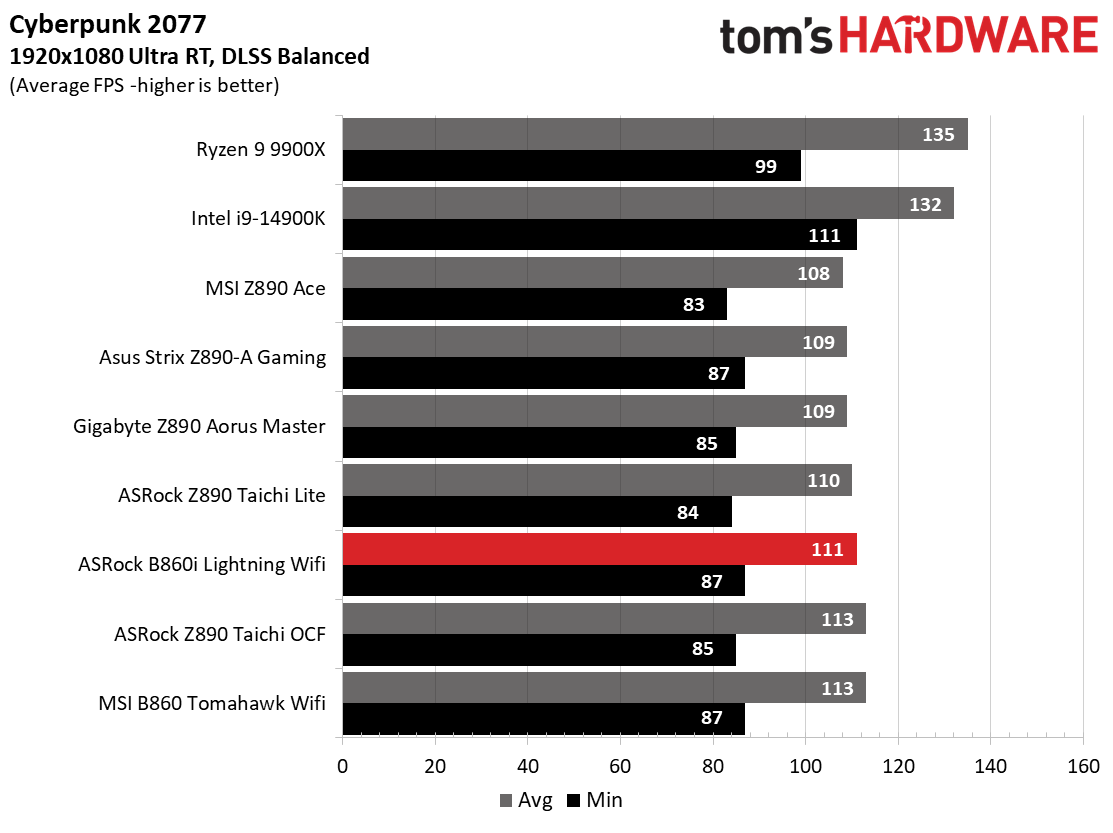
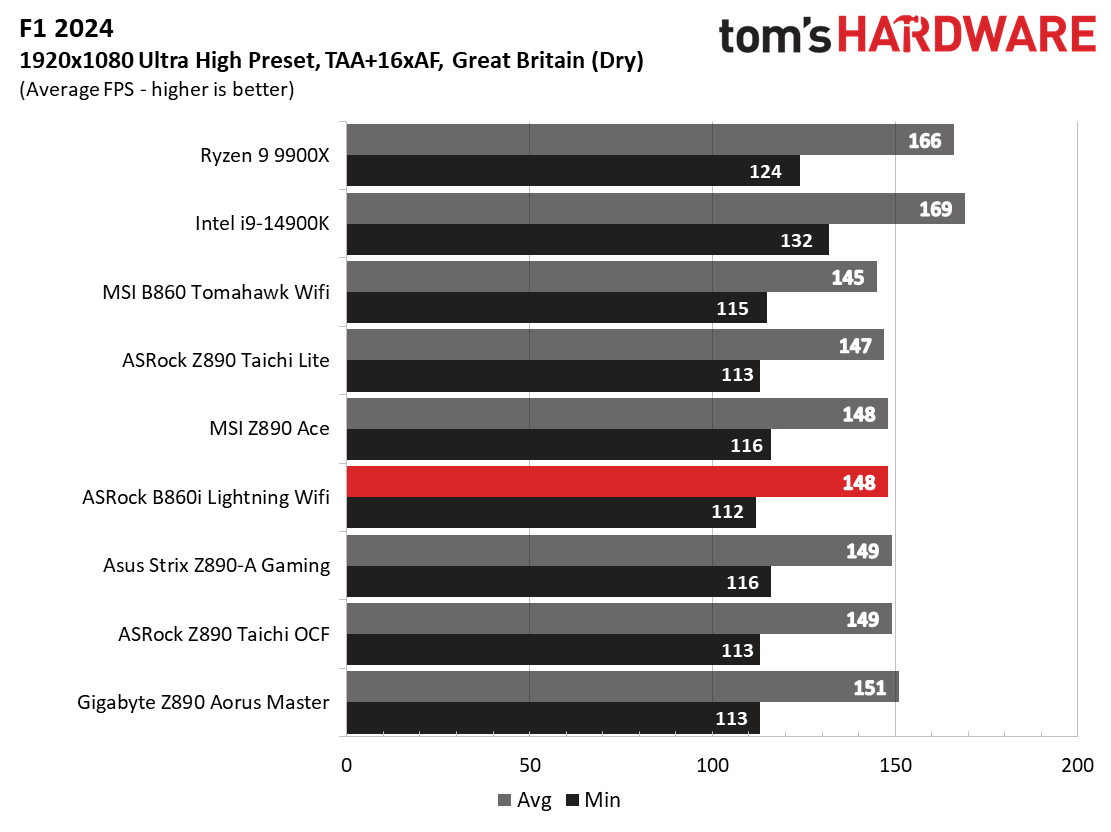
Starting with the launch of Zen 5, we’ve updated our game tests. We’re keeping the F1 racing game but have upgraded to F1 24. We also dropped Far Cry 6 in favor of an even more popular and good-looking game in Cyberpunk 2077. We run both games at 1920x1080 resolution using the Ultra preset (details listed above). Cyberpunk 2077 uses DLSS, while we left F1 24 to native resolution scaling. The goal with these settings is to determine if there are differences in performance at the most commonly used (and CPU/system bound) resolution with settings most people use or strive for (Ultra). We expect the difference between boards in these tests to be minor, with most falling within the margin of error differences. We’ve also added a minimum FPS value, which can affect your gameplay and immersion experience.
When it comes to gaming, this board was as average as can be, both in game tests and synthetic evaluations. There's nothing to be concerned about here; it performs just as well as any other.
Overclocking
Over the past few CPU generations, overclocking headroom has been shrinking on both sides of the fence while the out-of-box potential has increased. For overclockers, this means there’s less fun to have. For the average consumer, you’re getting the most out of the processor without manual tweaking. Today’s motherboards are more robust than ever, and they easily support power-hungry flagship-class processors, so we know the hardware can handle them. There are multiple ways to extract even more performance from these processors: manually adjust the settings or use some of the fancy AI overclocking board partners have been touting. Results will vary and depend on the cooling and quality of the CPU. In other words, your mileage may vary. Considering the above, we’re not overclocking the CPU for these review articles. However, we will try out our different memory kits to ensure they meet the specifications.
Get Tom's Hardware's best news and in-depth reviews, straight to your inbox.
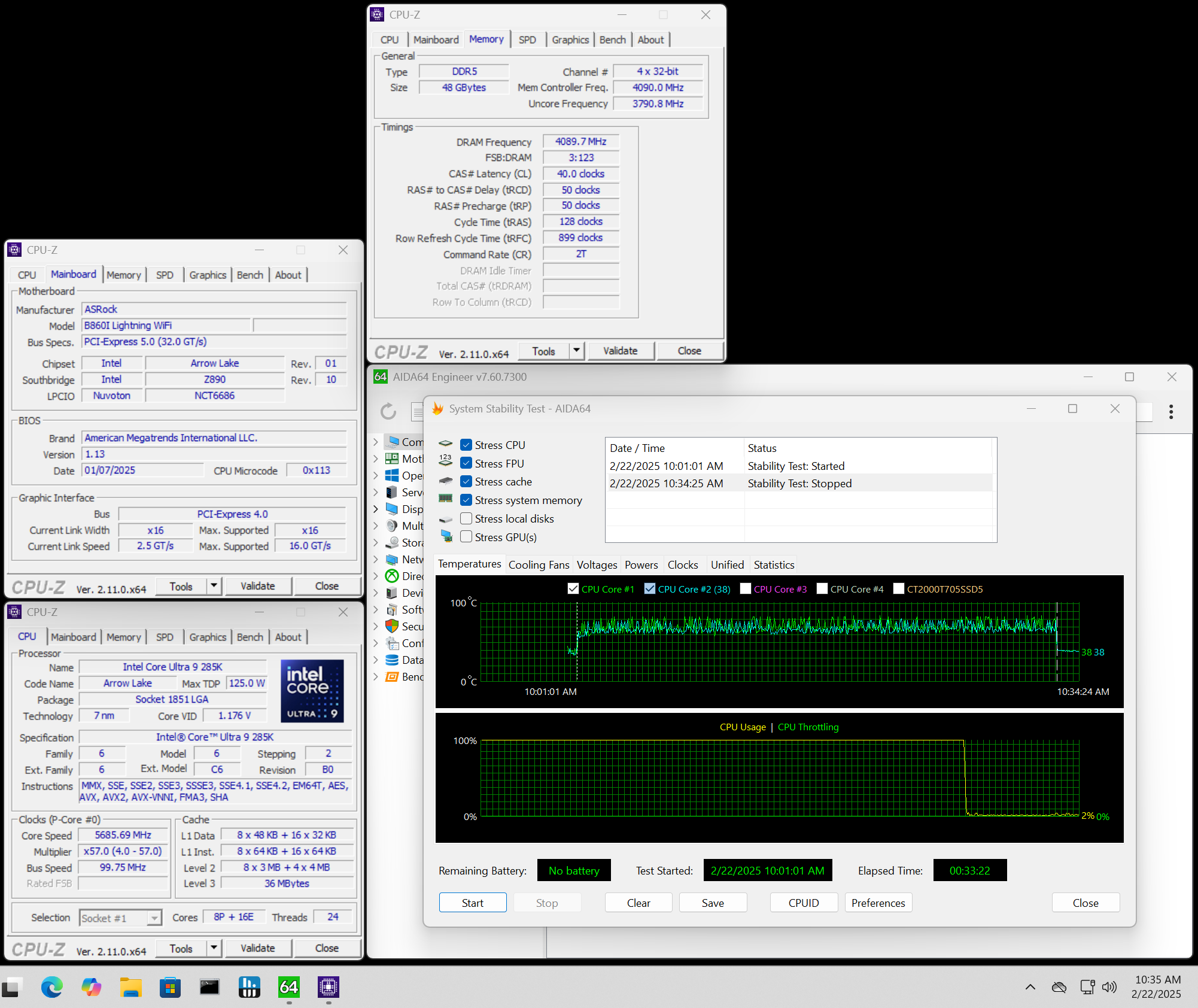
The B860I Lightning managed any memory we had below its fast DDR3-9333 limit without any issues. The Kingston and GSkill DDR5-8200 kits booted up and passed the stress test. This behavior is expected, as the speeds fall within the specified maximum. I wouldn’t advise pushing much beyond this, as the value-to-performance ratio isn’t favorable.
Power Consumption / VRM Temperatures
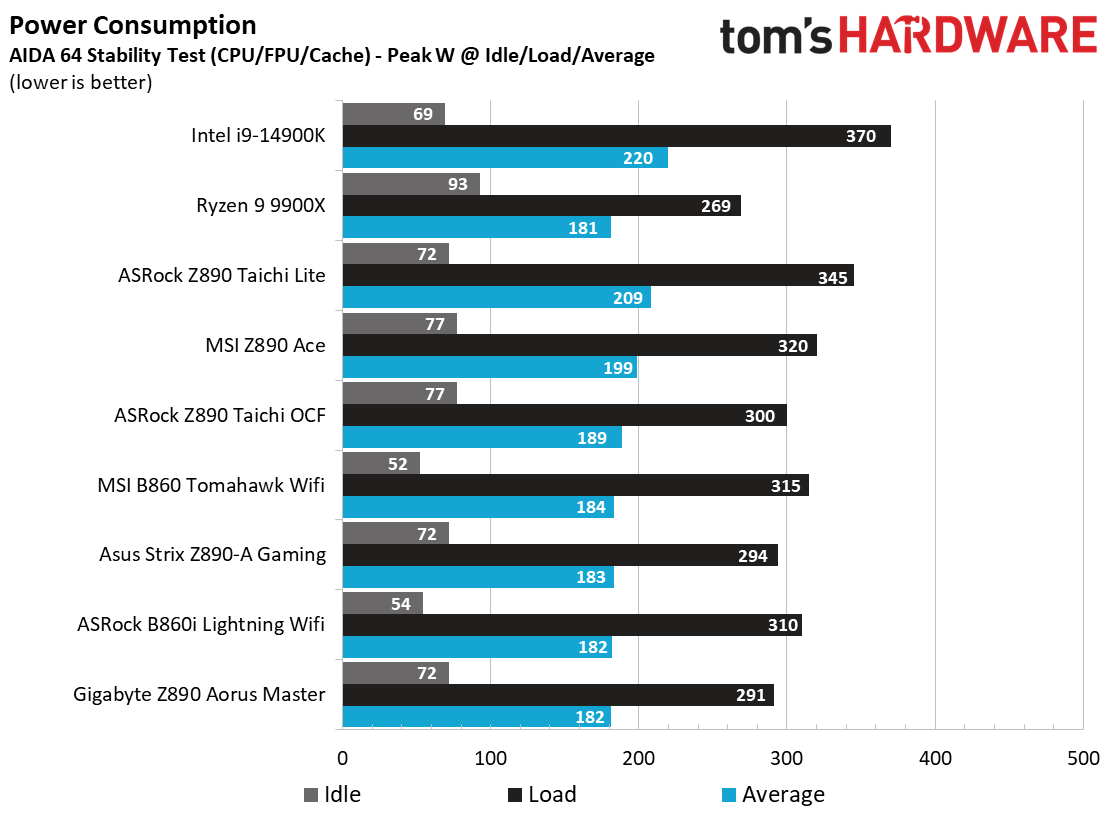
We used AIDA64’s System Stability Test with Stress CPU, FPU, Cache, and Memory enabled for power testing, using the peak power consumption value from the processor. The wattage reading is from the wall via a Kill-A-Watt meter to capture the entire PC (minus the monitor). The only variable that changes is the motherboard; all other parts remain the same. Please note we moved to use only the stock power use/VRM temperature charts, as this section aims to ensure the power delivery can handle flagship-class processors.
Our Core Ultra 9 285K system peaked at 310W at the wall (with the CPU reaching 219W) and surprisingly ranks on the higher end of power consumption during our stress test. However, idle power offsets this, with the system resting at around 54W, one of the lowest levels we’ve recorded.
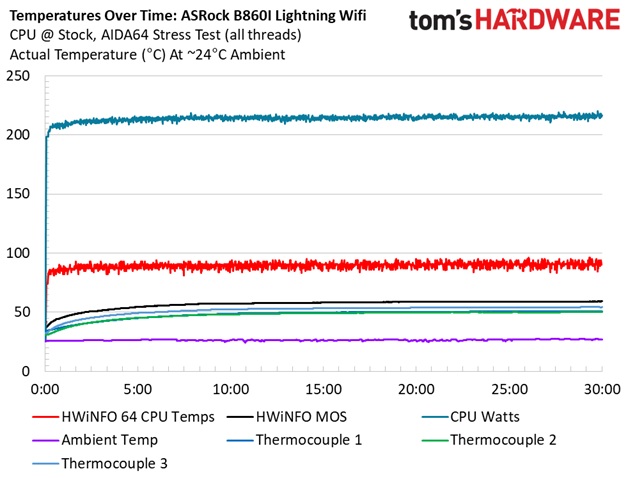

The VRM temperatures on our actively cooled heatsinks peaked at around 54 degrees Celsius, the highest we’ve recorded, but it's acceptable for the average 214W it managed. As for that little VRM fan, you could only hear it during the stress test. I want to explore other Mini-ITX boards to see if their passively cooled heatsinks perform better or worse.
Bottom Line
ASRock’s B860I Lightning Wifi has many strengths. Priced at $219.99 on Newegg, it offers good value for the price. It also delivers stable power, ample connectivity options, and a Thunderbolt 4 Type-C port. While performance was occasionally inconsistent, it remained average across various tasks. Taken alone, it’s worth every dollar spent.
However, competition is fierce in this motherboard segment. Asus’ ROG Strix B860-I Gaming Wi-Fi ($219.99) includes Wi-Fi 7 and a 20 Gbps port. Gigabyte’s B860I Aorus Pro Ice ($229.99) also provides Wi-Fi 7, includes some DIY-friendly features, and is arguably the most attractive option in icy white. However, it’s important to note that all of these boards also have their drawbacks.
The B860I Lightning is a versatile Mini-ITX motherboard that provides almost everything the platform can offer. However, if you’re one of the few who need Wi-Fi 7 in your build (or think you might want it in the near future), you’ll have to turn to a competitor. Otherwise, the Lightning has a lot to offer and should not be overlooked in the budget Mini-ITX market.
MORE: Best Motherboards
MORE: How To Choose A Motherboard
MORE: All Motherboard Content

Joe Shields is a staff writer at Tom’s Hardware. He reviews motherboards and PC components.
-
HideOut Although the audio codec on this board is not the most up-to-date, it's still far better than the 8xx codex the many more budget friendly boards use. It has thunderbolt 4 and 2.5 gig ethernet. It also seems to be pretty well built and it's built by a company that should still be here 6 months from now. This is probably one of the best budget-friendly itx boards we've seen in recent memory.Reply -
SonoraTechnical Reply
I agree.... ACS1200 is decent enough... Thunderbolt and 2.5 gig Ethernet are a surpise in a budget board too (though how budget is $200?) I'd would have liked to have seen 2x PCIe 5.0 nVME M.2 slots, but it don't think it's a show stopper for the 2nd HD in a system that is more long time file storage, rather than OS and Application launching. I'd have this direct wired, so the WiFi 6 would go unused anyway, so no issue that it's not the greatest WiFi 7 standard (my current stuff, modem, router, access point, don't even support Wifi 6 either).HideOut said:Although the audio codec on this board is not the most up-to-date, it's still far better than the 8xx codex the many more budget friendly boards use. It has thunderbolt 4 and 2.5 gig ethernet. It also seems to be pretty well built and it's built by a company that should still be here 6 months from now. This is probably one of the best budget-friendly itx boards we've seen in recent memory.
If I decide to go Ryzen R9 9950X3D and Radeon RX 9070XT on my Summer build as opposed to Ryzen AI MAX+ 395 w/ Radeonn 8060S iGPU , this might be a good board to purchase to offset some costs... -
LaminarFlow Last year I was trying to self-build a NAS and was torn between cheap Zen 3 (A520) vs Zen 4 (A620) ITX boards. Zen 3 ones tend to have 4 SATA ports but only Gb Ethernet, whereas Zen 4 ones come with 2.5GbE yet only 2 SATAs. Either way I have to use an adapter/PCI-E card of some sort. Eventually I went for A620 and a 8500G. It works but still leaves a bad taste in my mouth.Reply
This thing has 3 SATA ports...what kind of monstrosity is this?o_O -
thestryker I'd really like to see SATA ports dropped in the ITX format (honestly ditch them period) and replaced with SlimSAS ports because those can be dual use (SATA or NVMe). In the case of this board having just 2 SlimSAS ports would allow for one hybrid (4x SATA or 1x NVMe) and one NVMe giving more storage capability with less physical board space than the existing 3x SATA ports.Reply -
thestryker Reply
You're not going to see 2x (or more) PCIe 5.0 M.2 slots on the vast majority of ARL motherboards because the CPUs support 16x PCIe 5.0 lanes for slots, 4x PCIe 5.0 lanes for M.2, and 4x PCIe 4.0 lanes for M.2. That means the only way you're getting a second PCIe 5.0 M.2 is halving the lanes off the primary slot.SonoraTechnical said:I'd would have liked to have seen 2x PCIe 5.0 nVME M.2 slots, but it don't think it's a show stopper for the 2nd HD in a system that is more long time file storage, rather than OS and Application launching. -
SonoraTechnical Replythestryker said:You're not going to see 2x (or more) PCIe 5.0 M.2 slots on the vast majority of ARL motherboards because the CPUs support 16x PCIe 5.0 lanes for slots, 4x PCIe 5.0 lanes for M.2, and 4x PCIe 4.0 lanes for M.2. That means the only way you're getting a second PCIe 5.0 M.2 is halving the lanes off the primary slot.
Yeah, I know it's a limit with the current Ryzen architecture.... Threadripper would be different. LOL... Just speaking my mind.. Wish we had more PCIe 5.0 lanes available on the consumer grade CPUs.. -
thestryker Reply
Well AMD has enough lanes for 2x PCIe 5.0 x4 M.2 slots and some of the 600 series chipset boards have just that. When AMD mandated USB 4 support in the 800 series chipsets that took one of those away. Given that Intel has a PCIe 5.0/4.0 split on their CPU M.2 lanes now perhaps that'll change to 2x PCIe 5.0 x4 down the road.SonoraTechnical said:Yeah, I know it's a limit with the current Ryzen architecture.... Threadripper would be different. LOL... Just speaking my mind.. Wish we had more PCIe 5.0 lanes available on the consumer grade CPUs.. -
ocer9999 Honestly, Wi-Fi 6E is still plenty fast for most setups. Unless you're living in a Wi-Fi 7-enabled world, the B860i Lightning board offers a solid mix of features without breaking the bank.Reply
